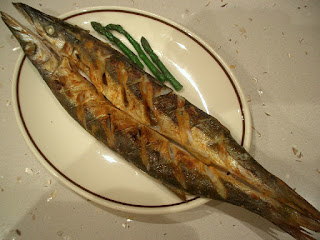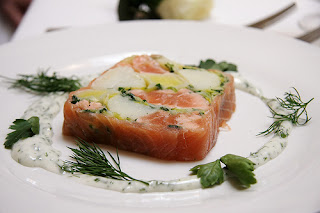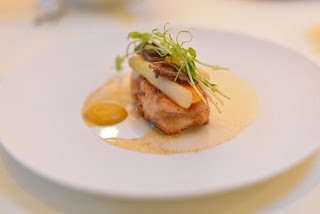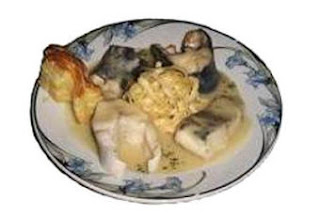from
Behind the French Menu
by
Bryan G. Newman
behindthefrenchmenu@gmail.com
Photograph courtesy of katdaned
www.flickr.com/photos/katdaned/2951756603/
Brochet or Grand Brochet du Nord
Pike; Northern Pike; American
Pike; Jack; Jackfish or Pickerel.
Pike are one of the tastiest freshwater fish. They have firm white flesh and are much appreciated both on their own and as an essential part of many freshwater fish stews. Pike is also the fish behind the original French quenelles, pike meat dumplings.

Two grilled baby pike.
Photograph
courtesy of Alpha
www.flickr.com/photos/avlxyz/47080864/
Pike is popular in France
Pike is a popular game fish, and much more frequently seen on French fish restaurant menus than those of North America or the UK. Pike is a very bony fish, and the smaller fish served in restaurants require a great deal of work in the kitchen. However, from listening to a French chef discussing this, I discovered how they speed up the deboning process. A small whole pike that will be served baked, braised, or grilled is first lightly-cooked for 10 to 15 minutes in a fish stock. Then the pike’s otherwise very problematic bones may be easily removed. After deboning the fish, it may be prepared as filets or re-assembled and baked as a whole fish, cooked, and served without bones.

Pike
Photograph courtesy of
Biodiversity Library.
www.flickr.com/photos/biodivlibrary/6007967093/
(N.B. When reading a menu with the word Brochet, count the numbers of t's. A menu may be offering brochettes, so watch the spelling. Brochettes (note the two t's) are skewers of grilled meat, fish, or vegetables. Brochet with a single "t" is pike, the fish).
Quennels.
Initially, pike was the only fish used to prepare quenelles, fish dumplings. Traditionalists still consider it an act of lésé majesté when fish quenelles are made with any fish other than pike. These pike dumplings originated in the 18th century and were initially sold by bakers. Bakers made flour and or puff pastry dumplings that could be added to a soup. Then, adding pike and later poultry or veal to the bread or puff pastry dumplings was a relatively short and tasty step.

Quenelle de
Brochet, Sauce Nantua.
Sauce Nantua is a Béchamel sauce today flavored
with shrimp butter, though it was initially made with freshwater crayfish for
which the town and lake of Nantua in the department of Ain in the
Auvergne-Rhône-Alpes; was famous. Today, from over-fishing and pollution, any
crayfish in Nantua will not be local, and tomato paste may assist with the
sauce’s color, but it remains a tasty sauce. The town of Nantua still has a
reputation for creative chefs.
Photograph courtesy of
Jean-Marc ALBERT
www.flickr.com/photos/jeanmarcalbert/8300073072/
Pike on French menus:
Quenelle de Brochet au Sauce Mornay - Pike dumplings with a Mornay sauce. Sauce Mornay is a child of Sauce Béchamel, which itself is a nutmeg flavored white sauce. To make Sauce Mornay from a Sauce Bechamel, add Gruyere or Parmesan cheese. Quenelles will be the main dish, the French plat principal.
Terrine de Brochet aux Petits Legumes – A pike fish pate made together with young vegetables. A pike pate is very different from a pike quenelle. Quenelles are made with 50% or more puff-pastry or flour, and the sauce is of great importance. A pike pate will be at least 75% fish, with little or no flour. Pike terrines may be decorated with vegetables or shrimp and rarely served with a sauce.

Salmon
and pike terrine.
Photograph courtesy of Adrian
Scottow.
www.flickr.com/photos/chodhound/5649493436/
Brochet du Lac, Fumé à Froid, Garni de Salades - Cold-smoked, lake caught pike served with small salads.
Brochet au Beurre Blanc Nantais – Pike, served with Nantaise butter sauce. The butter sauce from the city of Nantes. Sauce Beurre Blanc or Sauce Beure Blanc Nantaise is made with crème fraiche, butter, a dry white wine, (locally that would be a Muscadet, elsewhere it may be a Chablis), lemon, and shallots. This sauce is one of the tastiest and most popular butter sauces served with white fish, seafood, or vegetables. The city of Nantes is the capital of the region of the Pay du Loire.

Brochet au Beurre
Blanc Nantaise
Pike with a Beurre Blanc sauce.
Photograph
courtesy of Maison Graviere
Brochet Braisé au Champagne - Pike, braised in champagne. I have enjoyed this dish where a sparkling cremant from the Alsace was used instead of Champagne, and it was terrific.
Matelote de Brochet, Perche, Anguille, Tanche au Vin Blanc – A matelote is a freshwater fish stew. Here pike, freshwater perch, freshwater eel, and tench are in the stew. French freshwater fish stews often contain pike, as they are a tasty fish. A stew like this will be prepared with added white wine and herbs. Pike is a bony fish, but when cooked in a stew or soup the bones mostly dissolve. Pike bones add significantly to the taste and texture of fish soup.

Matelote de
Poissons au Reisling.
A fish stew with Reisling
wine.
Photograph
courtesy of Cuisine Collection
Pike are among the longest though not the heaviest European freshwater fish. Large fish, caught in the wild, can reach over 120 cm (40”) or more. The pike that a restaurant buys may have been caught in the wild; however, they will not be that large. Most wild pike will be much smaller, between 1.5 kilos – 3 kilos (3 lbs – 7lbs) and 55 cm – 70 cm ( 2ft – 2.5 ft) long. Pike are also raised on fish farms, and these will be even smaller. The smallest sold may be just 500 grams (1.1lb). A 500-gram pike will serve two, or one if you are very hungry. When the head, tail, and bones have been removed, some 200-250 grams of meat will be left. Pike’s long aerodynamic shape gave pike its name. According to Dictionary.com, the origins of the name pike, the fish, comes from Old English, where the word pic meant a point.

Catch your own pike.
Photograph courtesy of Fiske
Tretton.
www.flickr.com/photos/fisketretton/9912777054/
N.B. Translated French menus may sometimes confuse brochet which is pike in English with a fish called pike-perch in the UK and zander in the USA. Pike-perch/zander is a somewhat similar-looking fish and called sandre or perche-brochet in French. Pike-perch/zander comes from a different family to pike, and it is a different tasting fish.
Pike in the language of France’s neighbors:
(Catalan - lluç de riu or luci), (Dutch - snoek), (German – hecht ) (Italian - luccio), (Spanish - lucio).
Pike in other languages:
(Chinese (Manadarin) - 白斑狗鱼); (Danish- gedde); (Greece - tούρνα, tourna), (Hebrew - pickerel tzfoni - פיקרל צפוני), (Icelandic – gedda); (Japanese – kawakamasu); (Latvian – gjedde); (Polish – szczupak); (Portuguese –Lúcio); (Rumanian – Ştiucă); (Russian - obyknovennaya schuka); (Ukrainian –shtschuka); (Turkish - turna baligi). For these translations, thanks go to FishBase: Froese, R. and D. Pauly. Editors. 2014. FishBase. World Wide Web electronic publication. www.fishbase.org, version (11/2014).
--------------------------------
Behind the French Menu
by
Bryan G. Newman
behindthefrenchmenu@gmail.com
Copyright 2010, 2015, 2017, 2020.
--------------------------------
Are you searching for the explanation of words,
names,
or phrases on French Menus?
Just add the word, words, or phrase that you are searching for to the words "Behind the French Menu" and search with Google. Behind the French Menu’s links include hundreds of words, names, and phrases that are seen on French menus. There are over 470 articles that include over 4,000 French dishes with English translations and explanations.
------------------














